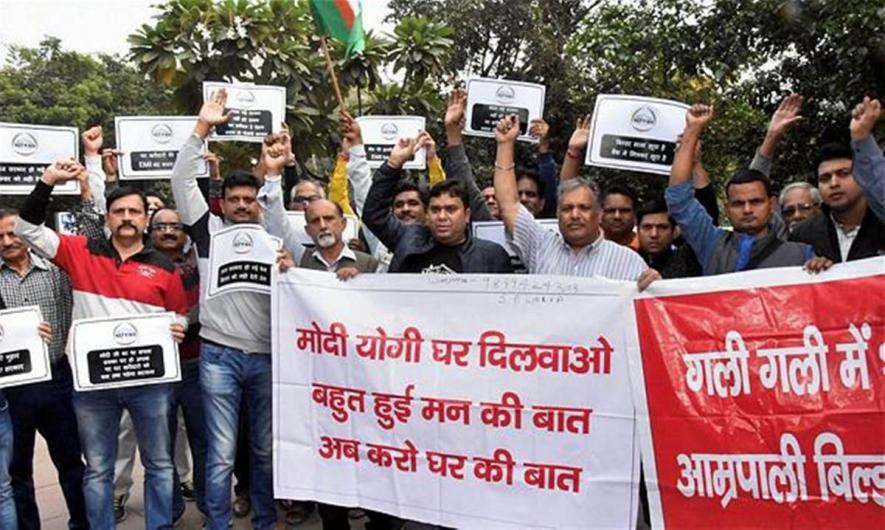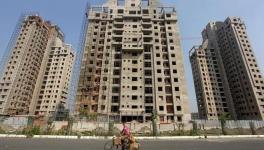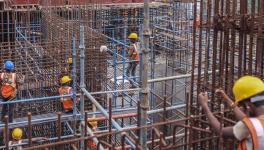Recent Developments in Real-Estate a Mixed Bag for Home-Buyers

Photo Credit- The Indian Express
Kolkata, Feb 20 /--/ The beginning of a rescue exercise for stalled housing ventures and new instances of conflict between home-buyers and builders mark the latest realities in the real-estate sector on the ground.
The start of a rescue exercise follows appropriate action by authorities with a Rs 25,000 crore special window for funding stalled affordable and middle income (AMI) housing projects. It was cleared by the Union Cabinet on November 6, 2019 and announced on the same day by Finance Minister (FM) Nirmala Sitharaman.
The origin of the second aspect, that of a builder-home buyer conflict, lies in the Centre’s decision to further amend the Insolvency and Bankruptcy Code, 2016, to restrict the freedom currently available to home buyers to move against developers.
The November 6 announcement by the FM was, in fact, the second of its kind in less than two months. On September 14 last year, a Rs 20,000 crore special fund was announced to bail out stuck AMI housing ventures. There were demands for a better package due to some restrictive features and the Centre came out with what it called an Alternative Investment Fund (AIF) – a debt fund -- with a higher corpus of Rs 25,000 crore and an expanded scope.
SBICAP Ventures, an asset manager, was the AIF’s designated investment manager. The Centre was to provide Rs 10,000 crore for the corpus and SBI, LIC and some sovereign wealth funds and pension funds were to take care of the remaining balance of Rs 15,000 core. At the time, it was officially claimed that the fund would potentially cover 1,600 projects with 4.58 lakh dwelling units (1,509 projects as per industry estimates, according to a PIB release on November 7 about the new special window). Priority was to be accorded to AMI projects which were “very close to completion”. The realty sector told the Centre that 90% of the stalled projects were under the AMI segment.
As per ANAROCK, a real-estate services company, Delhi-National Capital Region (NCR) has the maximum number of stalled projects (at least 67) among the top seven cities, comprising more than 1.18 lakh dwelling units. These projects were launched either in 2013 or prior, and are currently worth Rs 82,120 crore. Nearly 71% of these stalled units are sold out. The Mumbai Metropolitan Region has the second highest number of stalled dwelling units – 38,060 worth Rs. 80,220 crore, with nearly 60% of these units being sold out.
When asked by NewsClick whether the eligibility criteria was stiff, ANAROCK Property Consultants chairman Anuj Puri said it initially appeared that the government had reservations about projects which were reckoned to be non-performing assets (NPAs) and also those before the National Company Law Tribunal (NCLT). Later, however, the Centre decided to include NPAs and also projects before the NCLT, based on inputs received from stakeholders.
Dwelling on the prevailing situation, Puri said that property prices were quite low at the moment and that developers were cautious about launching new AMI projects with units priced up to Rs. 80 lakh. According to him, developers are limiting new supply in the market, focusing on completing projects which are lying incomplete and clearing unsold stock.
The Bengaluru property market has been witnessing difficult times for the last 18 months; to be more precise, since the IL&FS collapse. A good number of projects were halted midway due to a liquidity crunch, according to Kishore Jain, President of the Bengaluru branch of the Confederation of Real Estate Developers Association of India (Credai). Non-Banking Finance Companies (NBFCs) are normally the primary source of funds for developers but after the ILF&S debacle, funds from this source stopped, triggering a ripple effect onto other sources as well.
Jain told NewsClick that they had urged authorities to direct banks to take over existing NBFC loans and ensure funding and that if taking over of the loans was difficult, the banks should fund ventures on a pari passu basis.
According to those in the know in Tamil Nadu, there are about a dozen stalled ventures in the state, including one in Coimbatore. The state government’s concerned agency for alternate investment had taken stock of the situation before submitting a funding proposal to SBICAP Ventures.
In Indore, there is an overwhelming preference for buying land and constructing individual houses. It also has the practice of land owner/seller and the builder setting up joint ventures. A lack of clarity about the application of Goods and Services Tax (GST) was a major problem faced by prospective house owners and finally, when there was some clarity, investors found the GST rate of 5% on completed houses to be high. That, in addition to GST on materials worked out to 18% and stamp duty at 12.5% also acted as a dampener, Indore’s Credai chief Liladhar Maheshwari told NewsClick. There was a strong case for reducing GST on houses to a maximum of 2% and stamp duty to 5%.
How has the industry reacted since the AIF-announcement on November 6, 2019?
The first closure happened on December 6, 2019; exactly a month after AIF was announced. About Rs 10,530 crore, which is about 80% of the target, was raised against the fund size of Rs 12,000 crore with investors including SBI, LIC and HDFC, among others. The sum of Rs. 10,530 crore could suffice to close projects of an aggregate size of Rs 65,000 crore / complete one lakh units which are stuck, assuming a multiple of six times. This is because only last-mile funding will be provided, according to SBICAPS Managing Director Sanjiv Chadha who told this to CNBC TV 18 in an interview.
It appears that the investment manager was attaching lot of importance to the NCR region which “boasts” the largest number of stalled ventures. The Noida administration was pursuing the matter of stuck ventures in their jurisdiction with the investment manager. A few meetings had taken place at Ghaziabad with senior executives of SBICAP Ventures. Sushant Gupta, Director at Credai, NCR, told NewsClick that those who had attended the meetings found the fund executives pro-active in assessing viability of stuck cases and taking matters forward.
ANAROCK’s Puri said that as per information with the government, some cases for funding had since been cleared and a number of cases had gone through preliminary rounds of due diligence.
The Home Buyer- Builder Conflict
The conflict has its origin in the decision of the Department of Corporate Affairs (DoCA) to inter alia amend the existing Section 7 (1). The section provides that when a default has occurred, the financial creditor, either by itself or jointly with other financial creditors, or any other person on behalf of the financial creditor, as may be notified by the Central government, may file an application for initiating the corporate insolvency resolution process against a corporate debtor before the adjudicating authority.
The Union Government has sought to amend this provision through The Insolvency And Bankruptcy (Second Amendment) Bill, 2019, which was cleared by the Cabinet on December 11, 2019 and introduced by Nirmala Sitharaman in the Lok Sabha on the following day. The bill is currently with the Parliament’s standing committee on finance.
The proposed legislation seeks to insert a provision that for financial creditors who are allottees under a real estate project, an application for initiating corporate insolvency resolution process shall be filed jointly by not less than 100 such allottees under the same real estate project or not less than 10% of the total number of such allottees under the same real estate project, whichever is less. This move has been strongly opposed by the Forum for People’s Collective Efforts (FPCE), which looks after interest of home buyers.
In a representation to the chairman of the standing committee, Jayant Sinha, FPCE president Abhay Upadhyay, also member of the central advisory council of Real Estate Regulatory Authority (RERA) said they are totally opposed to the proposed amendment as it puts unreasonable conditions on home buyers. Upadhyay has pointed out that before proposing the amendment, the DoCA did not care to ascertain the views of home buyers. According to him, the DoCA was only trying to accommodate the views of developers and their associations.
Sale is a continuous process and it is not possible for a home buyer to keep track of the sale of dwelling units in a project. It will also be very difficult to collect contact details of the requisite number of buyers. Moreover, assuming a home buyer succeeds, there will always be a time lag between them moving the NCLT and the application’s admission. The builder may well try to cause a split among the homebuyers and thereby ensure that the threshold is not met and the application is dismissed even before its admission.
National Real Estate Development Council (Naredco), an outfit of developers / builders, has contended that aggrieved customers have the opportunity to approach RERA, consumer fora and the NCLT. Also, in its view, the threshold of 10% or 100 flat owners, whichever is less, is a soft condition. If, however, more than two-thirds of allottees give their consent, the matter may be referred to NCLT, subject to an undertaking that they would not approach RERA.
The writer is a senior journalist based in Kolkata
Get the latest reports & analysis with people's perspective on Protests, movements & deep analytical videos, discussions of the current affairs in your Telegram app. Subscribe to NewsClick's Telegram channel & get Real-Time updates on stories, as they get published on our website.
























